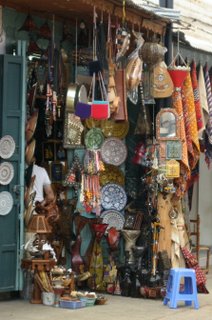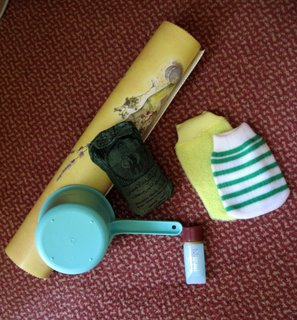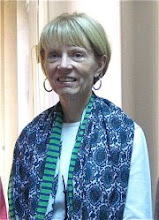
I did make a few contacts today. When the going got slow, I went to the public hammam on Zankat Kobrah Street, just outside the medina and the old city walls. It was quite different from the one I went to in Damascus. That one was in an old Ottoman building and quite an experience. It sold soft terry towels and bathing accessories, had several rooms for steaming, which were quite hot, a large washing area, and a room where you could lounge in your terry cloth robe and enjoy a glass of tea with a hookah, if you wished. This one was definitely modest by comparison, but busy even on a Monday. To the uninformed, the entrance to the hamman was not obvious or noticeable from the outside. With some searching and a closer look, I saw an older woman looking after the entrance to the "preparation" room, while a male attendant stood in a small, adjacent office collecting the fees. All the women assistants wore pink uniforms, when they weren't working in the hammam or washing people. Aren't you interested in knowing what they wore in the hamman? Clothes were removed in this entry area, put in a plain wood cubicle, watched over by an attendant behind a desk. Your washing equipment was put into a large plastic pail. As I entered the second room, I found that the steam was not strong at all. So Moroccan public baths are not nearly as hot as Turkish baths, as I had heard. While the roof was rounded, the decorations were basically plain light blue tiles. The entry way had more ornamental ones–the mass-produced kind you see in many people's homes and in civic buildings. This hamman was unquestionably more functional than attractive or ornate. Attendants did work to keep the place clean, continually mopping and pushing the water into drains with long-handled squeegees. A sign also says that the bath is sterilized so shoes and sandals aren't allowed. I sat on my mat on the tile floor. The attendant carried water drawn from a faucet, not zellij Arab-style basins, over in large, white plastic pails. First, there's a rinse or wetting of the body. The attendant pours some over herself–I guess for a refreshing, since the room is warm, if not hot, and a bit stuffy. Then, the dark, olive-oil based soap is rubbed all over your body and rinsed. While you are on your back, in a surprise move the attendant bends your legs at the knee, crosses them, and pushes them up toward your waist. With legs tense from walking, I was suddenly made to feel pointedly alive. Next, the roughing up takes place with the scruffing mitt you brought. I had brought two, one coarser than the other.

She chose the green-and-white striped, less rough one. Finally, the ghasoul (clay earth) is dissolved in your pouring cup (mine was aqua plastic, with a handle like a dipper; other bathers had some equivalent of the same) and worked into your hair and all over your body. The tayeba (washing attendant) put some on her own face. Then the final rinse takes place. It seems to end all too quickly. Just after the rinsing ends, you take up your towel, return to the entry room to dry yourself and put on your clothes. Some women sit lethargically on the bench along the wall, resting their feet on wood-lathe pallets and accompanied by a few young girls. I, however, wanted to get a bite to eat, so left after a few minutes–feeling really clean.
 I did make a few contacts today. When the going got slow, I went to the public hammam on Zankat Kobrah Street, just outside the medina and the old city walls. It was quite different from the one I went to in Damascus. That one was in an old Ottoman building and quite an experience. It sold soft terry towels and bathing accessories, had several rooms for steaming, which were quite hot, a large washing area, and a room where you could lounge in your terry cloth robe and enjoy a glass of tea with a hookah, if you wished. This one was definitely modest by comparison, but busy even on a Monday. To the uninformed, the entrance to the hamman was not obvious or noticeable from the outside. With some searching and a closer look, I saw an older woman looking after the entrance to the "preparation" room, while a male attendant stood in a small, adjacent office collecting the fees. All the women assistants wore pink uniforms, when they weren't working in the hammam or washing people. Aren't you interested in knowing what they wore in the hamman? Clothes were removed in this entry area, put in a plain wood cubicle, watched over by an attendant behind a desk. Your washing equipment was put into a large plastic pail. As I entered the second room, I found that the steam was not strong at all. So Moroccan public baths are not nearly as hot as Turkish baths, as I had heard. While the roof was rounded, the decorations were basically plain light blue tiles. The entry way had more ornamental ones–the mass-produced kind you see in many people's homes and in civic buildings. This hamman was unquestionably more functional than attractive or ornate. Attendants did work to keep the place clean, continually mopping and pushing the water into drains with long-handled squeegees. A sign also says that the bath is sterilized so shoes and sandals aren't allowed. I sat on my mat on the tile floor. The attendant carried water drawn from a faucet, not zellij Arab-style basins, over in large, white plastic pails. First, there's a rinse or wetting of the body. The attendant pours some over herself–I guess for a refreshing, since the room is warm, if not hot, and a bit stuffy. Then, the dark, olive-oil based soap is rubbed all over your body and rinsed. While you are on your back, in a surprise move the attendant bends your legs at the knee, crosses them, and pushes them up toward your waist. With legs tense from walking, I was suddenly made to feel pointedly alive. Next, the roughing up takes place with the scruffing mitt you brought. I had brought two, one coarser than the other.
I did make a few contacts today. When the going got slow, I went to the public hammam on Zankat Kobrah Street, just outside the medina and the old city walls. It was quite different from the one I went to in Damascus. That one was in an old Ottoman building and quite an experience. It sold soft terry towels and bathing accessories, had several rooms for steaming, which were quite hot, a large washing area, and a room where you could lounge in your terry cloth robe and enjoy a glass of tea with a hookah, if you wished. This one was definitely modest by comparison, but busy even on a Monday. To the uninformed, the entrance to the hamman was not obvious or noticeable from the outside. With some searching and a closer look, I saw an older woman looking after the entrance to the "preparation" room, while a male attendant stood in a small, adjacent office collecting the fees. All the women assistants wore pink uniforms, when they weren't working in the hammam or washing people. Aren't you interested in knowing what they wore in the hamman? Clothes were removed in this entry area, put in a plain wood cubicle, watched over by an attendant behind a desk. Your washing equipment was put into a large plastic pail. As I entered the second room, I found that the steam was not strong at all. So Moroccan public baths are not nearly as hot as Turkish baths, as I had heard. While the roof was rounded, the decorations were basically plain light blue tiles. The entry way had more ornamental ones–the mass-produced kind you see in many people's homes and in civic buildings. This hamman was unquestionably more functional than attractive or ornate. Attendants did work to keep the place clean, continually mopping and pushing the water into drains with long-handled squeegees. A sign also says that the bath is sterilized so shoes and sandals aren't allowed. I sat on my mat on the tile floor. The attendant carried water drawn from a faucet, not zellij Arab-style basins, over in large, white plastic pails. First, there's a rinse or wetting of the body. The attendant pours some over herself–I guess for a refreshing, since the room is warm, if not hot, and a bit stuffy. Then, the dark, olive-oil based soap is rubbed all over your body and rinsed. While you are on your back, in a surprise move the attendant bends your legs at the knee, crosses them, and pushes them up toward your waist. With legs tense from walking, I was suddenly made to feel pointedly alive. Next, the roughing up takes place with the scruffing mitt you brought. I had brought two, one coarser than the other.  She chose the green-and-white striped, less rough one. Finally, the ghasoul (clay earth) is dissolved in your pouring cup (mine was aqua plastic, with a handle like a dipper; other bathers had some equivalent of the same) and worked into your hair and all over your body. The tayeba (washing attendant) put some on her own face. Then the final rinse takes place. It seems to end all too quickly. Just after the rinsing ends, you take up your towel, return to the entry room to dry yourself and put on your clothes. Some women sit lethargically on the bench along the wall, resting their feet on wood-lathe pallets and accompanied by a few young girls. I, however, wanted to get a bite to eat, so left after a few minutes–feeling really clean.
She chose the green-and-white striped, less rough one. Finally, the ghasoul (clay earth) is dissolved in your pouring cup (mine was aqua plastic, with a handle like a dipper; other bathers had some equivalent of the same) and worked into your hair and all over your body. The tayeba (washing attendant) put some on her own face. Then the final rinse takes place. It seems to end all too quickly. Just after the rinsing ends, you take up your towel, return to the entry room to dry yourself and put on your clothes. Some women sit lethargically on the bench along the wall, resting their feet on wood-lathe pallets and accompanied by a few young girls. I, however, wanted to get a bite to eat, so left after a few minutes–feeling really clean.


0 Comments:
Post a Comment
<< Home